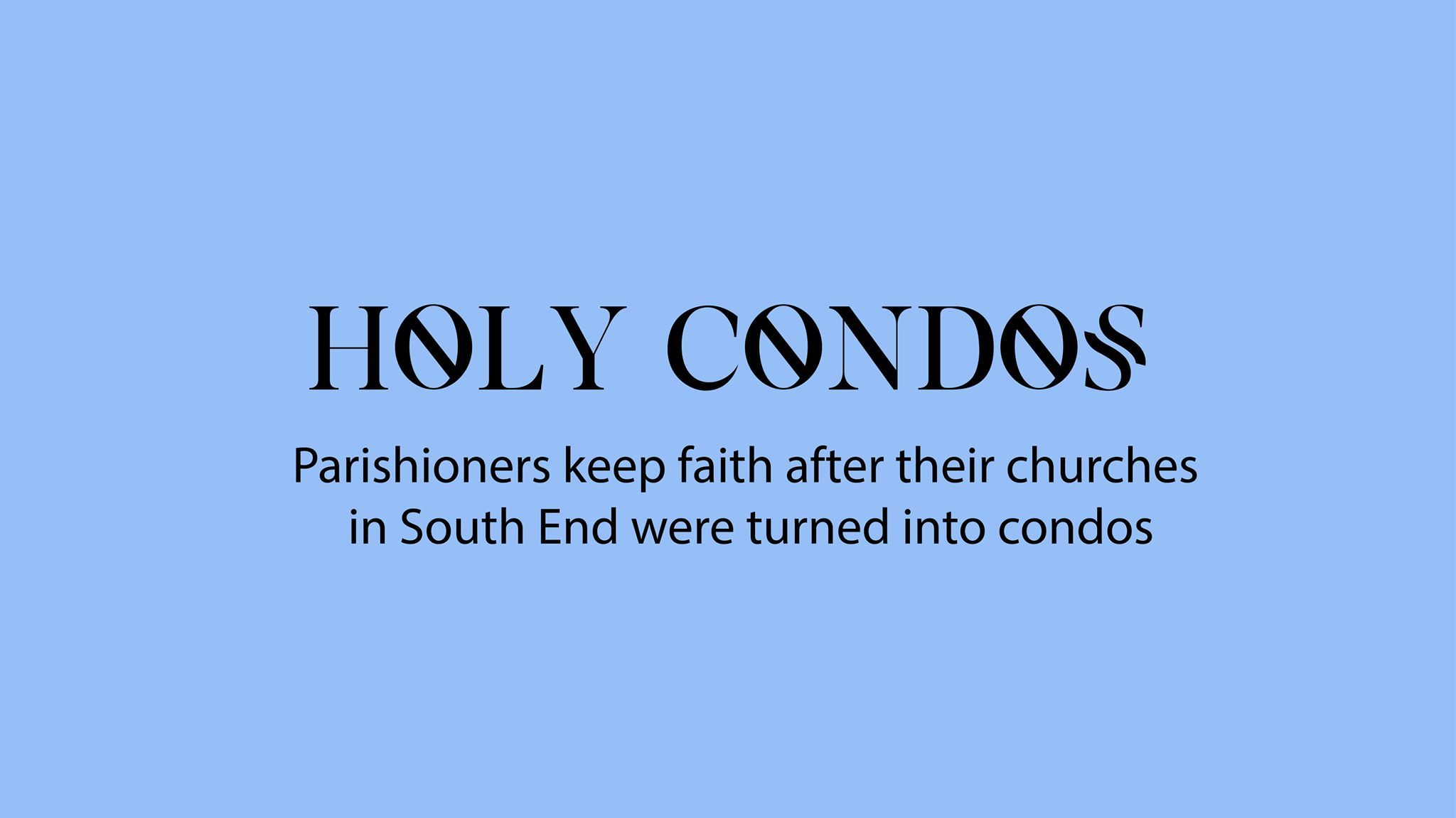
Rev. Willa S. Mines has been living in the South End since 1970 when she relocated from the South. One Sunday, looking for churches, she entered the Concord Baptist Church at 201, West Brookline Street in Boston.
“It was just so good. It reminded me of the South and reminded me of home. So, I felt like I had a home."
The Concord Baptist Church in the South End was home for Rev. Mines and all its members until 2011 when the congregation outgrew their space and were forced to move to Milton, Massachusetts, in part due to a lack of parking.
Rev. Mines now walks by what was once her church and looks at it grieving. The doors that were once open for service are now only open for the residents of nine new converted luxury condos that occupy the former church.
John Kelly feels the same sorrow, but at a different former church. He was raised at The New Hope Baptist Church at 740 Tremont St., in Boston.
"I love what it means to me. And it means the world to me," says Kelly recalling the memories he has of the church.
New Hope had its last worship service on Dec. 16, 2012. It closed due to the many repairs the building needed and the lack of parking. The congregation needed a bigger location and the church was sold to a developer who turned it into condos.
Now, Kelly continues playing at church like he used to do in the past, but in a different location. New Hope now worships at 1450 River St. in Hyde Park.
Kathleen O'Connell Salisbury looks at the building that was once her church with a gaze of nostalgia and horror. Her family attended the Holy Trinity Catholic German Church at 136 Shawmut Ave. since the late 1880s.
They immigrated from Ireland to Boston and settled in the South End, right across from the church that soon became their home.
"Till the day I die, it will always be a travesty that they did away with that church," O’Connell said.
The church was shut down by the Archdiocese of Boston in 2008 after four years of efforts by the parishioners to keep it open. It was sold to a developer in 2014 for $ 7 million.
The Holy Trinity doesn't exist anymore: its shell now hosts 33 luxury condos, a gym, a concierge and a lounge.
Rapid growth and development in the last 20 years have changed the face of the South End neighborhood. Once a place that hosted a mix of low-income and higher-end households, it has now become one of the most prestigious areas of Boston.
Among the most controversial transformations that occurred was what happened to the four churches of the neighborhood: Holy Trinity Catholic German Church, New Hope Baptist Church, Immaculate Conception and Concord Baptist Church.
The churches were gutted inside but their exteriors remain virtually untouched, faithful to the historical style of the neighborhood. From the outside they still appear to be a place of worship. However, inside they are one-of-a-kind homes that still boast oversized stained-glass windows and cathedral ceilings.
It's a scenario that has been repeated not only in the South End, but in other parts of the city with approximately other four houses of worship that have been converted into condominiums.
One of the first churches that was turned into condos is the Mount Vernon Congregational Church at 492 Beacon Street. The church, located in the heart of Back Bay, faced a devastating fire back in 1978 and architect Graham Gund transformed what remained of it into 38 luxury units in 1983.
The conversions continue. The Jesuit Urban Center, formerly Immaculate Conception, at 775 Harrison Ave., will soon open its doors as the Cosmopolitan.
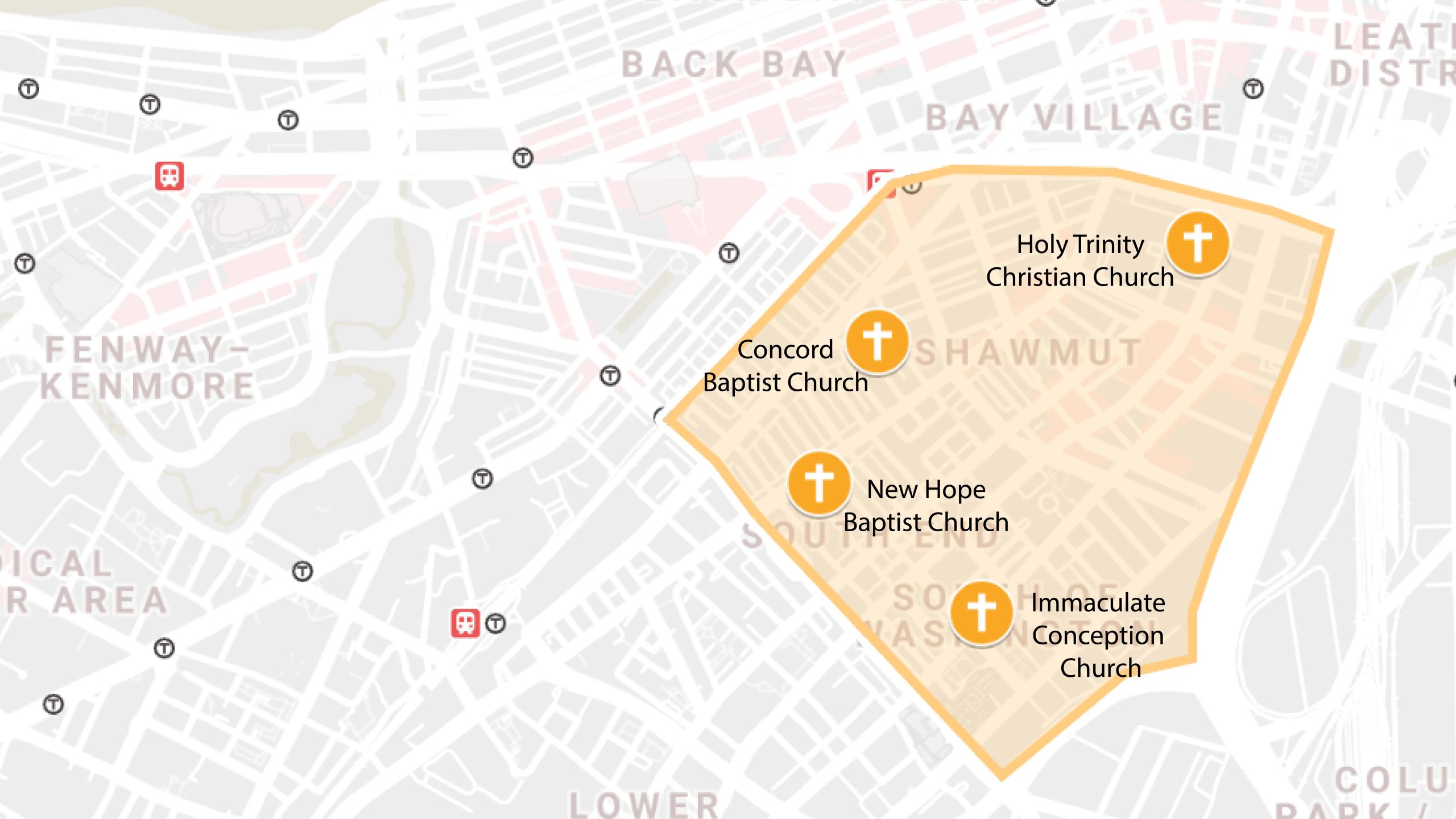

In the 1820s more than 5,000 German immigrants arrived in Boston and among them, there were the first German Catholics of the city. In 1840 Rev. John Raffeiner of New York saw the need for a permanent German parish with German clergy in Boston. A year later, a plot of land was purchased for $3,500 and in August, a nine-member committee assembled to oversee the construction of the church.
In June 1842, Father Raffeiner laid the first cornerstone of what in 1844 would become the Holy Trinity Catholic German Church.
The church served German and Irish immigrants for over 150 years, bringing to Boston and to the country their Christmas traditions. The Germans introduced the use of the Christmas trees and greeting cards to New England, making them mainstays of American culture.
Among all the immigrants that found a new home at Holy Trinity Church, was Kathleen O'Connell's family who immigrated from Ireland in the late 1880s.
"The church is family history because my mom's family when they came from Ireland, that's where they moved to in the South End, right by the church. They literally lived a street over," O'Connell said.
Her grandmother's oldest brother was baptized at Holy Trinity and her grandmother and aunts got married there.
The church was part of O'Connell's past and future. It is where she met her husband, John Salisbury, and where she fought to keep it open when in 2004 the Archdiocese contemplated closing Holy Trinity’s doors and selling it to pay off settlements incurred from numerous child abuse cases.
"I remember when we got the news of the closing of the church. People were crying like a relative died. It was really heartbreaking," O'Connell said.
After four years of battles, the church was shut down in 2008 and its community forced to leave.
Born as a diocesan parish, Holy Trinity was taken over by the Society of Jesus in 1848 that ran the community for 113 years. In 1961 the Archdiocese regained control until closing it forever in 2008.
It was the only Latin Mass authorized by the Boston Archdiocese and it started hosting the Liturgy in 1884.
The church was involved in many charitable causes such as Bridge Over the Troubled Water which benefits the homeless and at-risk youth, as well as the Cardinal Medeiros Center that provides healthcare to the homeless.
Some of the former members of the Holy Trinity have made the Cathedral of the Holy Cross at 1400 Washington St. their new home, trying to keep their traditions alive.
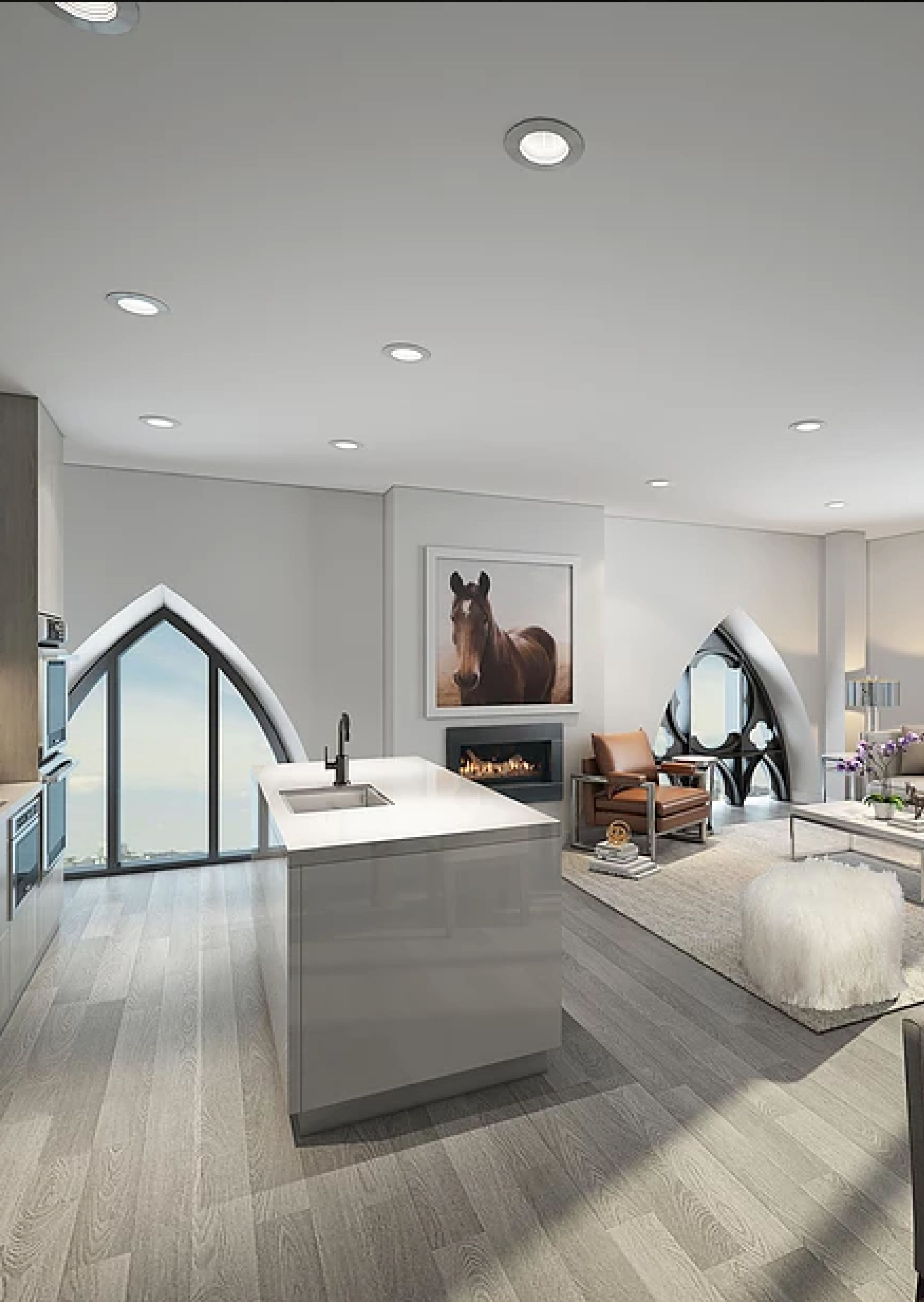
Photo courtesy of: The Lucas Boston apartments website
Photo courtesy of: The Lucas Boston apartments website



The Holy Trinity Catholic Church went on the market in June 2014 and was sold to a residential developer.
Finegold Alexander Architects partnered with the developers New Boston Ventures and Metric to construct the The Lucas, a luxury condominium building made up of 33 units.
In order to sell a church, the Archdiocese had to go through a long process involving the Vatican in Rome, a judicial process and the deconsecration of the building.
As as the developers began gutting the building, former parishioners of Holy Trinity discovered on a real estate blog that somebody was marketing it.
"They had pictures and all the development possibilities. It hadn't been deconsecrated. It was still technically, a church," said John Salisbury a former parishioner of Holy Trinity.
Work on the building finally began in 2015 and the architects started by pulling out the internal part of the church and keeping only the shell.
Most of the ornaments that made Holy Trinity beautiful, like the main altar and the two side altars, were sent to St. Joseph Cathedral in Manchester, New Hampshire. The church's lower altars now a new home at Our Lady of Good Voyage, 56 Seaport Blvd., in Boston.
In designing the residences, Finegold Alexander Architects said their aim was to maintain some of the history of the building while adding new aspects.
“We recognized the historic fabric was very significant," Jim Alexander of Finegold Alexander told Boston.com.
However, while the current residences may resemble the old church, Salisbury, the former parishioner, has mixed feelings. "You can still tell that Holy Trinity was there. So that's kind of nice. But on the other hand, you know, the history has been kind of wiped out," said Salisbury.
The prices of the condos range from $600,000 to $4 million per unit and sizes range from 650 to 3,500 square feet. The 33 one to four-bedroom units take up eight floors. The former church now offers condo owners many luxury amenities such as a concierge, gym, spa and a common courtyard complete with a fire pit.
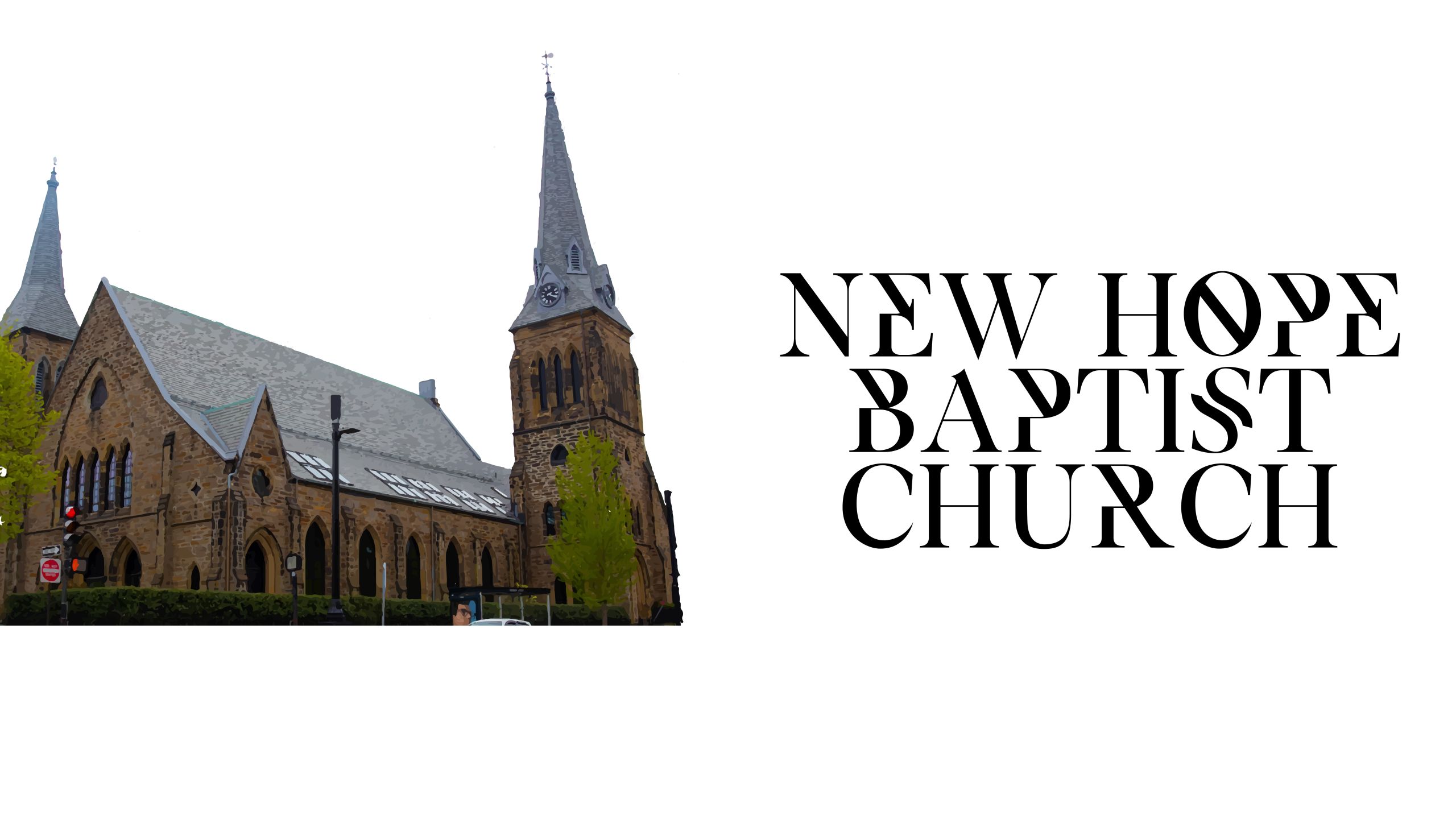
New Hope Baptist Church opened its doors in September of 1938 at 616 Shawmut Ave. in Roxbury.
Eight years later, when the church decided to purchase property at 600 Shawmut Ave. as the congregation grew, Marshall Cooper Jr.'s mother moved to Boston from South Carolina and started looking for a church.
"My mother went to that church when she first came here in 1946,” said Cooper.
When the rest of the family joined her in 1948, his mother took them to the church. Since then Cooper has remained a part of the church community.
He followed New Hope in 1968, when the congregation set in motion a rebuilding campaign. The aim was to raise funds to purchase and renew a Methodist Church's building located at 740, Tremont St..
The old style gothic church became the new home of the New Hope Baptist Church and of its 20 members, becoming through the years one of Boston's largest Black Baptist churches.
To leave and grow or to stop growing: This was the choice the congregation had faced in the early 2000s. As parking rules became more strict in the neighborhood, it became more difficult to park cars during services and the New Hope started losing its members.
"I just loved that building. I honestly hated to leave, didn't want to leave from that area, didn't want to leave from that building," said John Kelly, a member of the New Hope.
In October of 2012, the church sold the building due to many repairs that needed to be done as well as to the lack of parking. The last service was held on Dec. 16, 2012.
"I protested against moving. Because I love 740, but I know we had a parking problem. But after I didn't get my vote that we're going to stay there, I had to go along with the rest of the members. And I'm so glad that I did," said Cooper.
The worship continued in a temporary location at the Orchard Gardens School at 906 Albany St., Roxbury. More than two years after the move, in July 2014, New Hope found its new home in a former Catholic church at 1450 River Street in Hyde Park.
As in 1968, Cooper followed his community in the move: "We are family. That's what churches are made of families," he said.
When New Hope Baptist Church hit the market in 2011, a developer from Brookline, Michael Minkoff, stepped forward presenting a proposal to the South End Landmark District Commission to turn it into townhouse-style condos.
The decision to turn a place of worship into condos was not welcomed by all the members of the New Hope: "It just feels weird to me that it can go from being a place of worship to condominiums to be for money, for that type of thing," said Kelly.
Minkoff's original proposal was to create seven two-story townhouse units within the main sanctuary and parish hall. One of these units would have become Minkoff's new home.
As with similar projects, the developer aimed to maintain the historical exterior of the building.
Minkoff and architect Gary Hendren, created six townhouse-style condos that hit the market in 2013. The first of these units went on sale for $2.5 million.
Not everyone is a fan of look of the luxury condos.
"I drive by and look at it like it is now. It looks so ugly because they added another floor to it. And it didn't look like New Hope Baptist Church on 740," said Cooper.

Photo courtesy of: Nat Rea
Photo courtesy of: Nat Rea
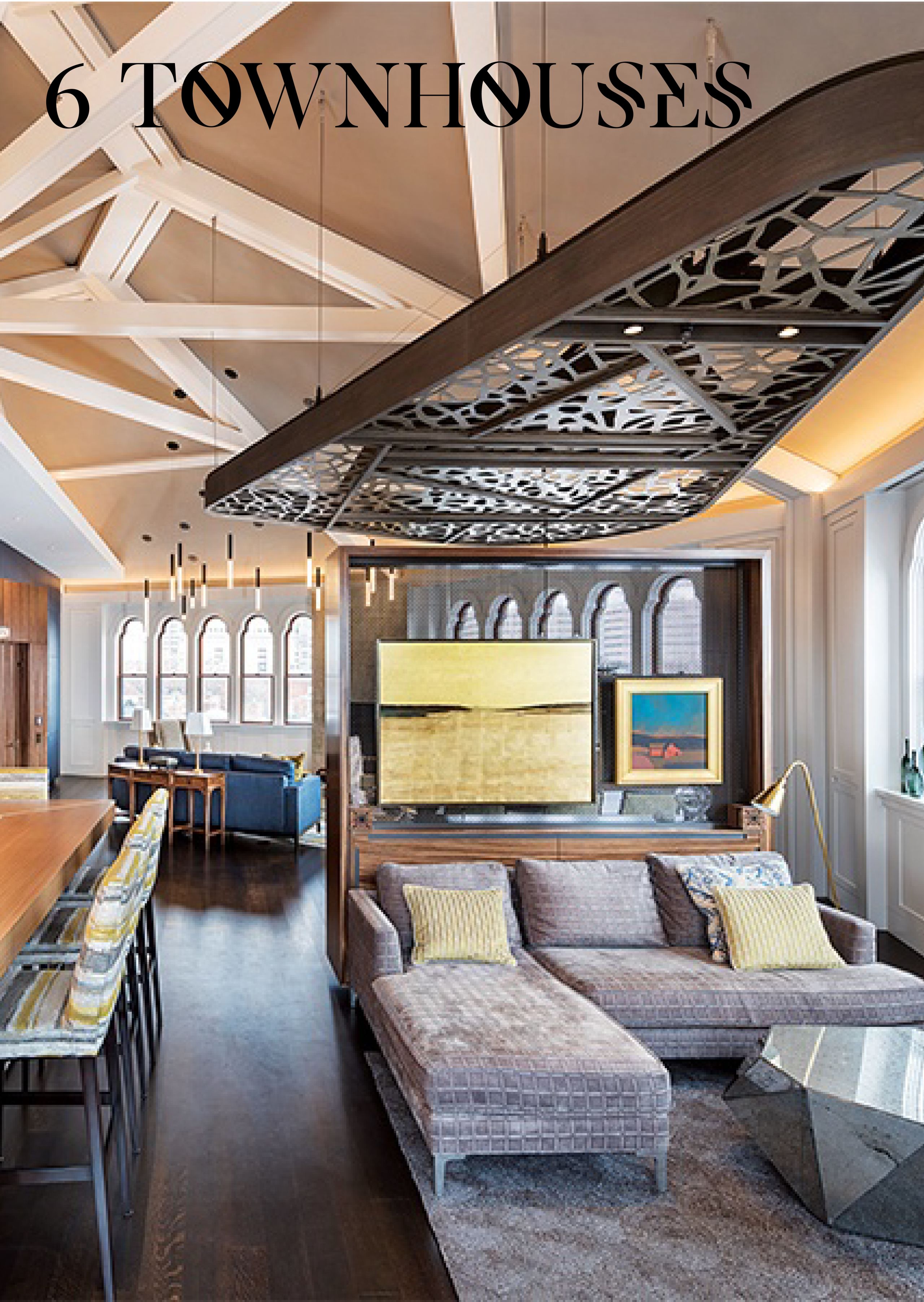
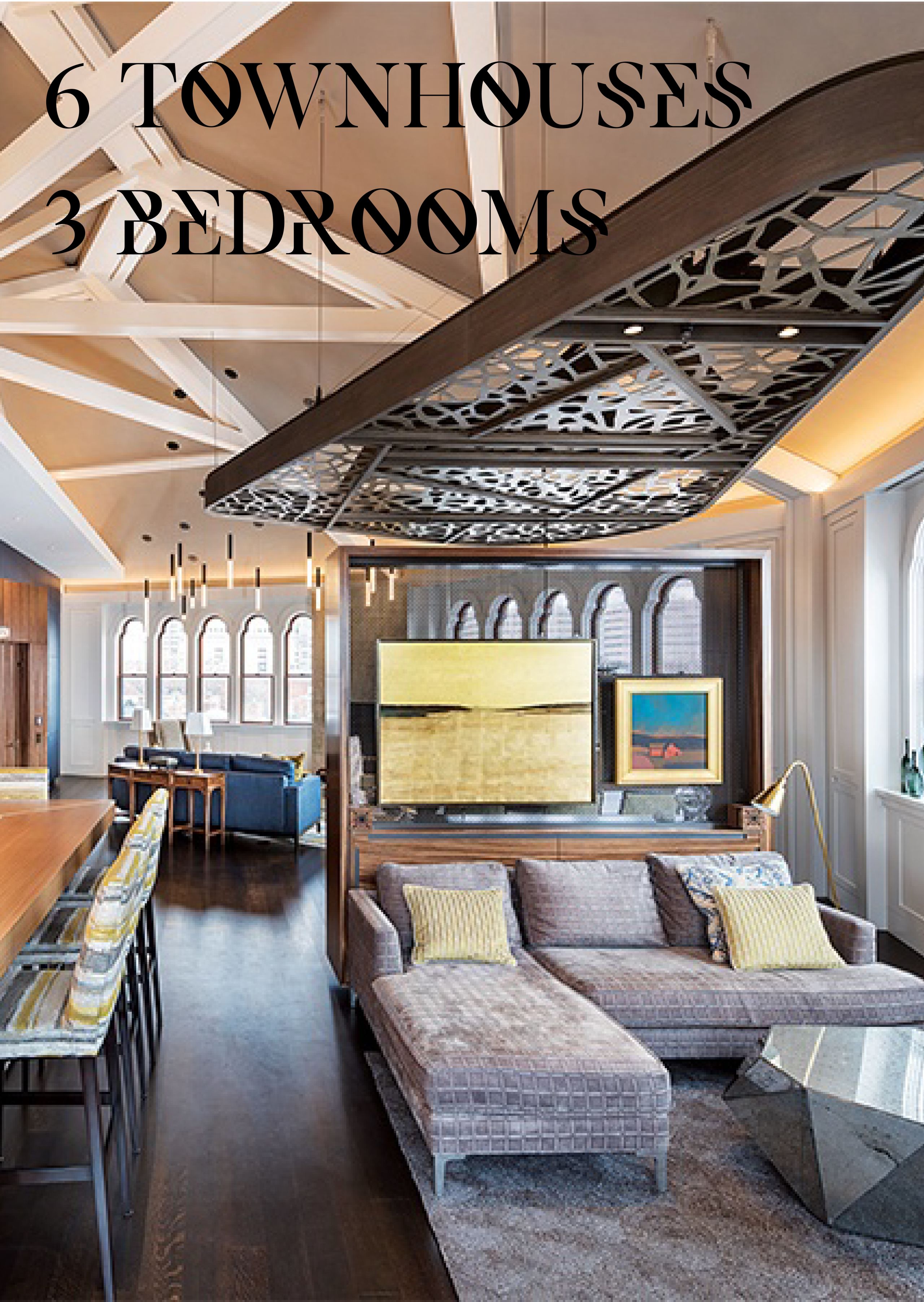
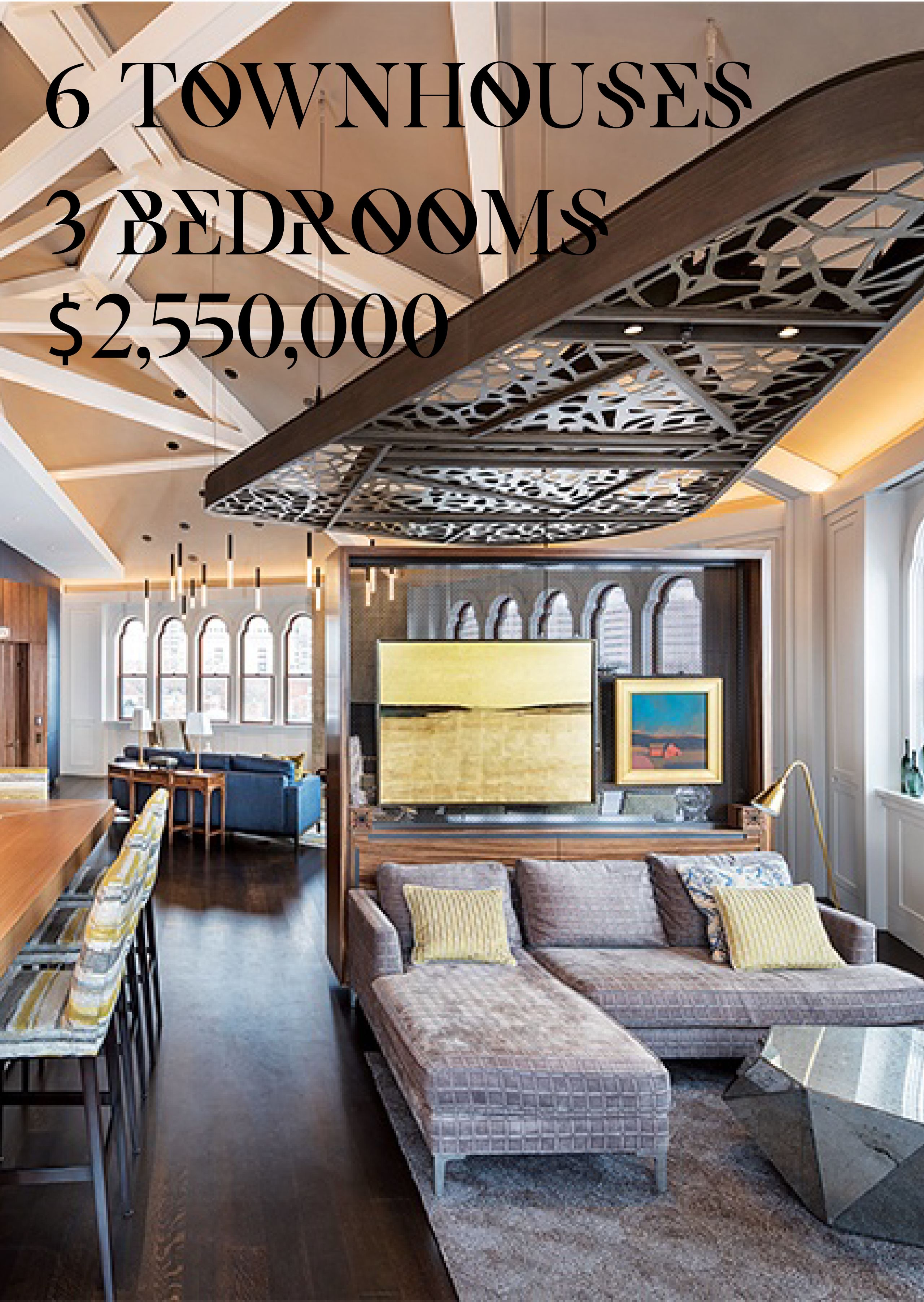
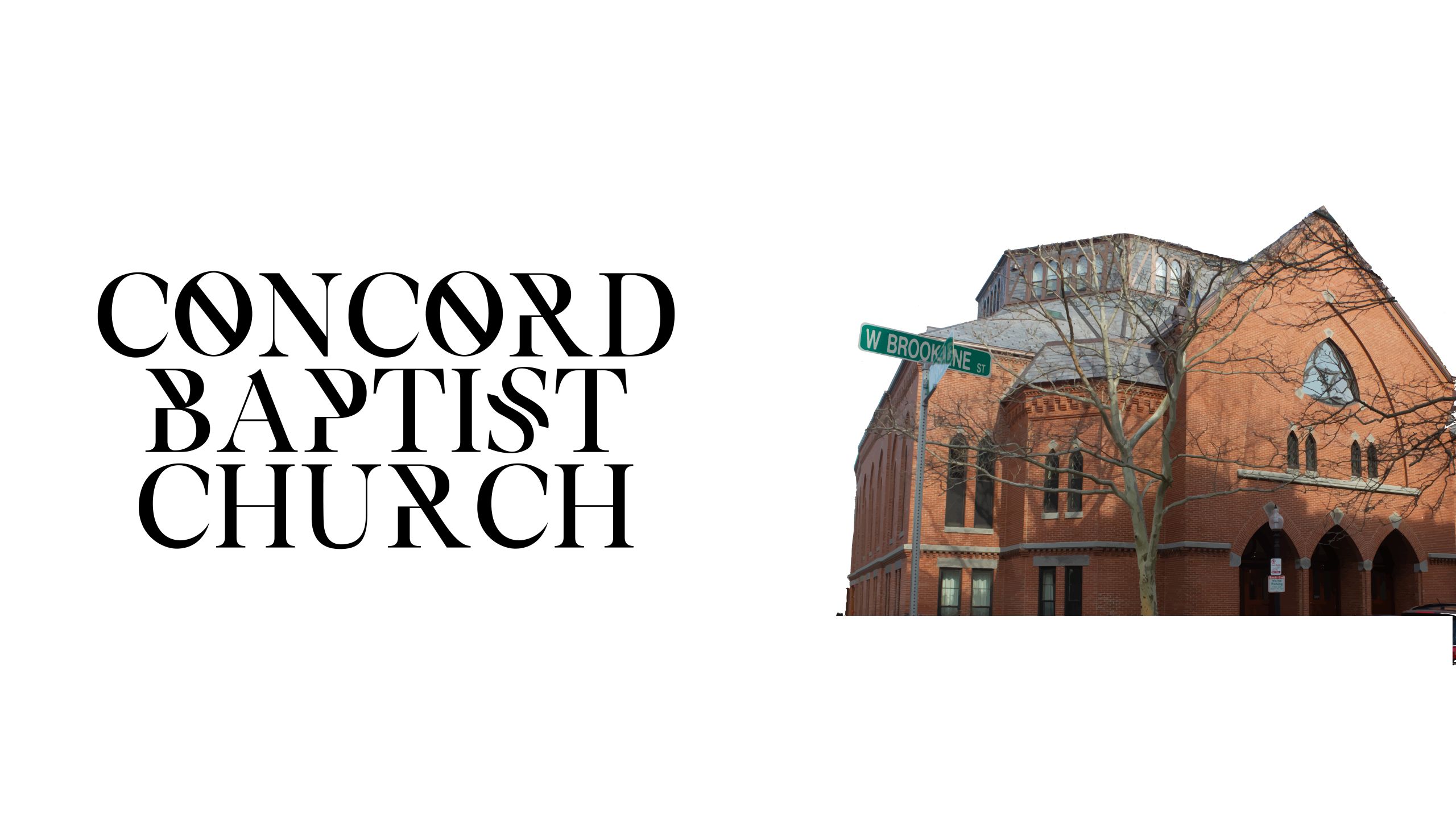
According to a history published by the church, in 1916, 16 people gathered for prayer at a private home and eventually realized that they needed a more established place to gather for worship. They formed what is now Concord Baptist Church of Boston. At first the church occupied a building in West Roxbury. Soon, it grew big enough to move to a new building in the South End.
In 1946, the church moved into a building at the corner of Warren Avenue and West Brookline Street. The building dated to 1869.
“In 1945, the building became available,” said Conley Hughes, the Reverend of Concord Baptist Church. “By that time, the church had grown to the point that we needed a large building. To move to that building at that time was a great move, and it was a building that was commodious - it met our needs.”
By the end of the century, the church outgrew the available space and could no longer accommodate needs of all the congregation.
“Our facility was not large enough to handle our ministries and the neighborhood has changed tremendously,” said Hughes. “We needed to be in a different place where we could continue to carry out the mission of the church.”
Lack of parking space in the crowded neighborhood became one of the biggest problems.
“I remember, there was a time where they allowed us the park in the middle of the street and they weren't giving out tickets,” said Tammy Texeria.
However, parking was allowed only during the time of services. Parishioners had to rush from the church to move their cars. They could not be late leaving from service, nor stay for the next one. Otherwise, they risked getting a ticket.
“You had to be out of church, you had to move your car by a certain time,” said Texeria. “The neighbors just were not friendly anymore.”
The church’s Executive Council had to make a decision to move to another building.
“We began the process of thinking about our future in 2003,” said Rev. Hughes. “For three years, we had a series of meetings.”
“We prayed about the move. To my recollection, it was a near unanimous decision to sell the building and to look for another site,” said Rev. Hughes.

Photo courtesy of: Justin Anfuso - Anfuso Imaging
Photo courtesy of: Justin Anfuso - Anfuso Imaging
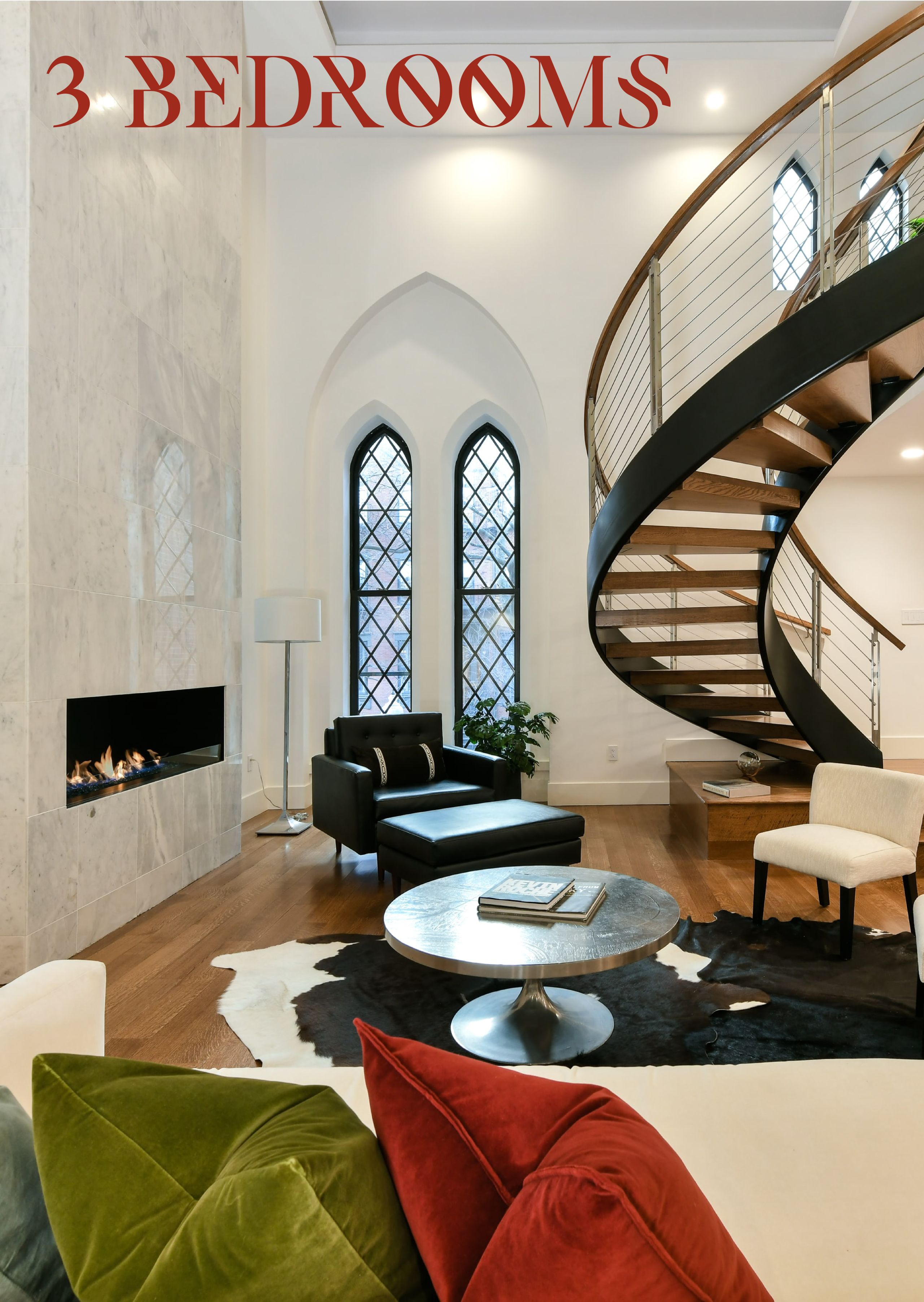
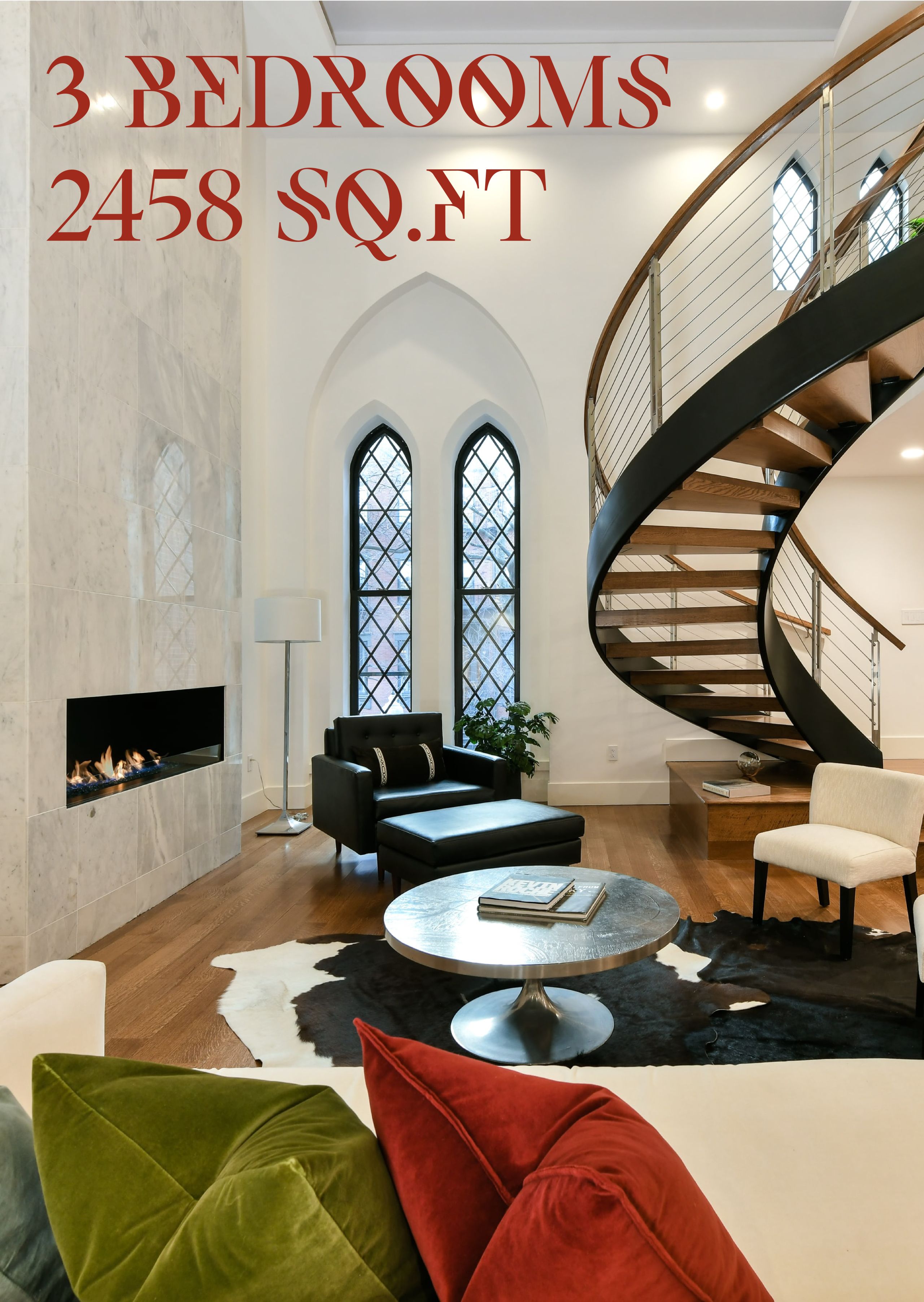
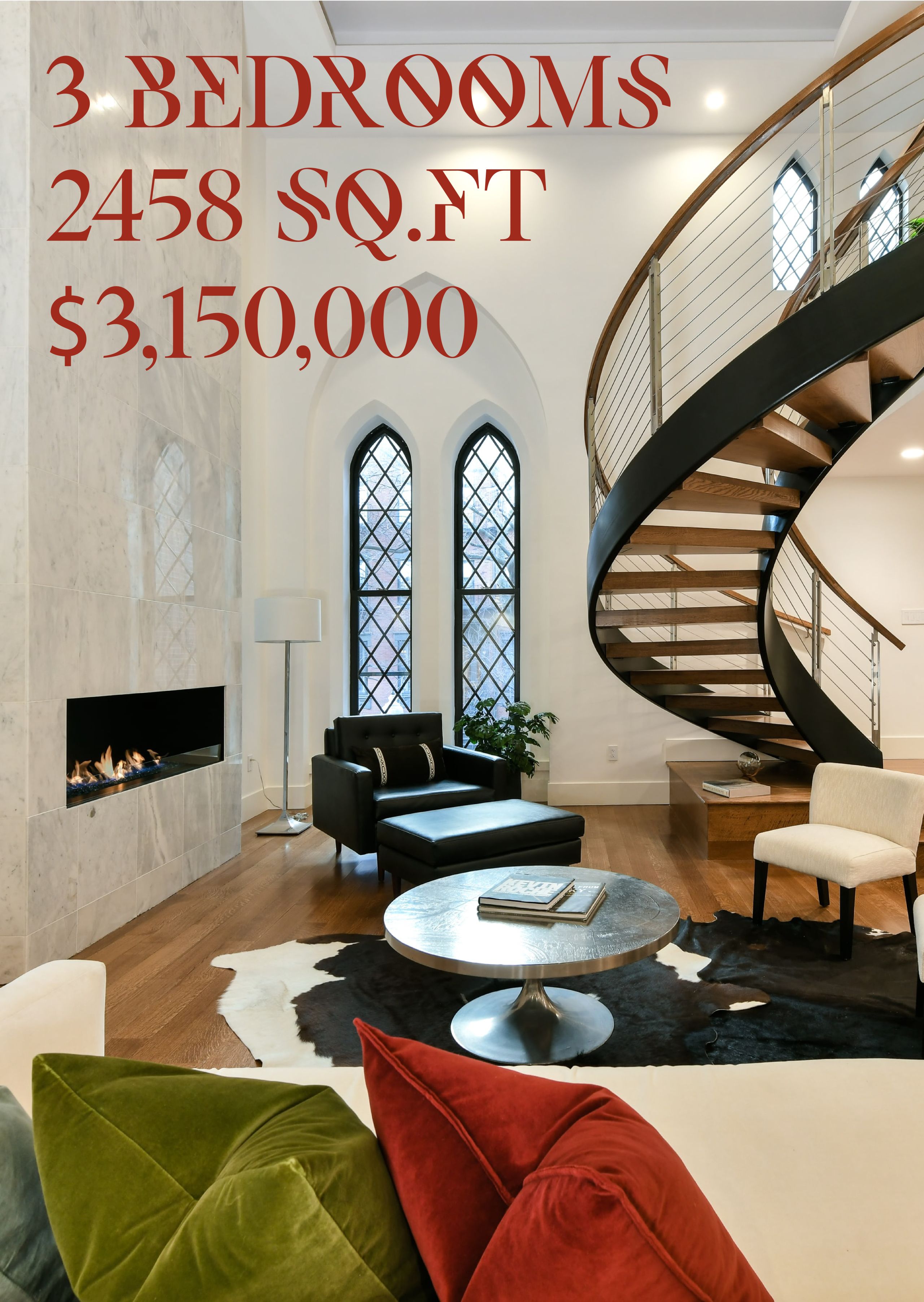
In 2008, developer Peter Zagorianakos met with members of the South End community to go over renderings of the construction plans to transform the church into condos.
He wanted to make changes to the exterior of the building, however, Jeanne Pelletier, of the South End Landmark Commission argued that the building was of high historic value and should not be changed externally.
Local residents also expressed concern about the potential impact of construction. They voiced opinions about parking for the condo residents as well as the safety of pedestrians.
In 2011, after years of fundraising, searching for the new location, and negotiating with the city and neighborhoods, Concord Baptist Church moved to a building that previously belonged to Jewish temple in Milton. The building was 22,000 square-feet and required little renovation.
After the sale of the church, negotiations about the design and other issues with the developer Zagorianakos, turned contentious.
The main concerns were preserving the historical nature of the building exterior, including the roof, and preserving the window lines. Last but certainly not least in an area with limited parking, the locals wanted to know how the the construction process would affect on street parking.
Once the issues were resolved, the units hit the market in January 2019 and asking prices were as high as $3 million.

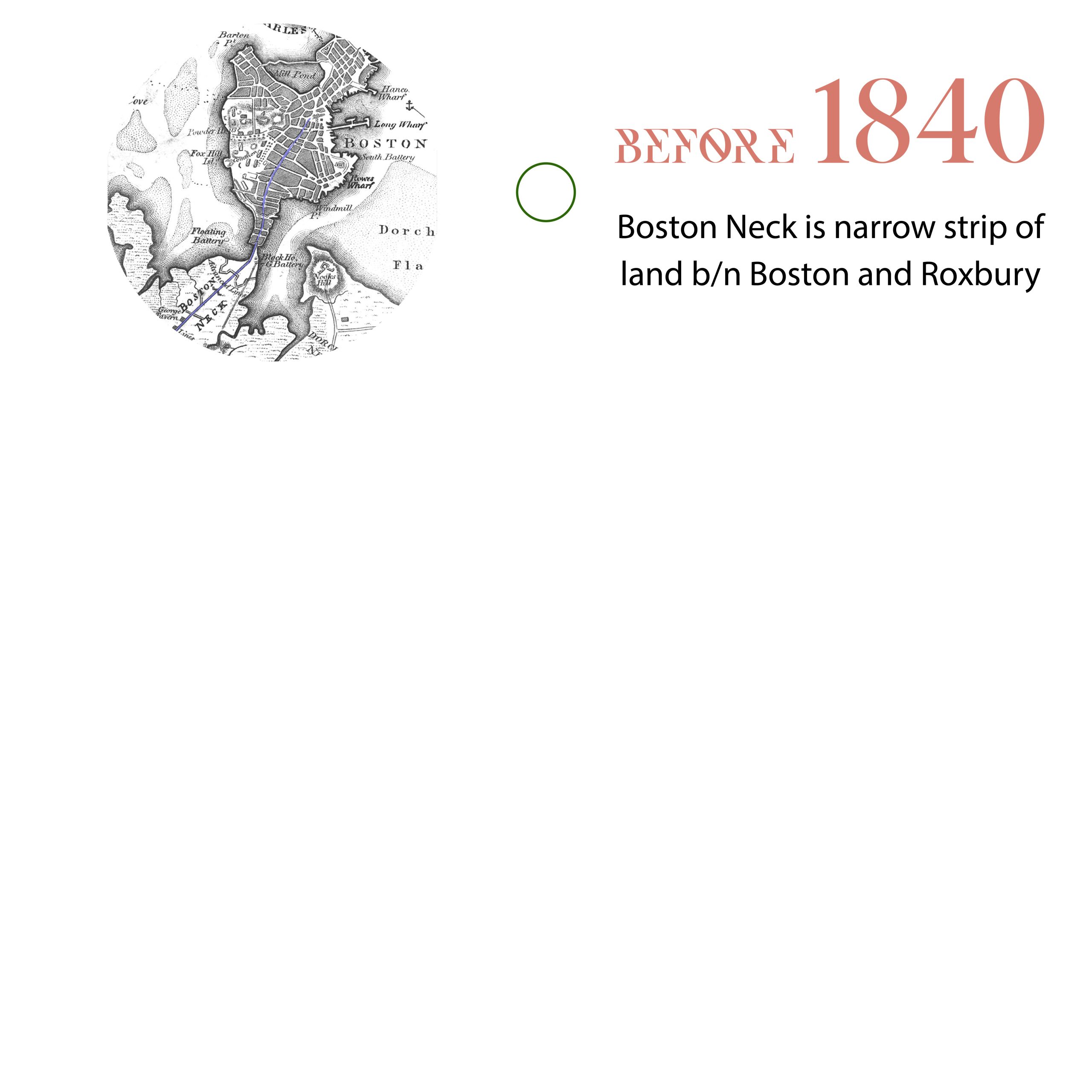
Prior to the 1840s, Boston’s South End was a narrow strip of land, the Boston Neck, connecting Boston to Roxbury and surrounded by a tidal marsh. The area included a few mansions. Because Beacon Hill and the downtown area became overcrowded, the city added land to the Neck in the 1840s, expanding the South End.
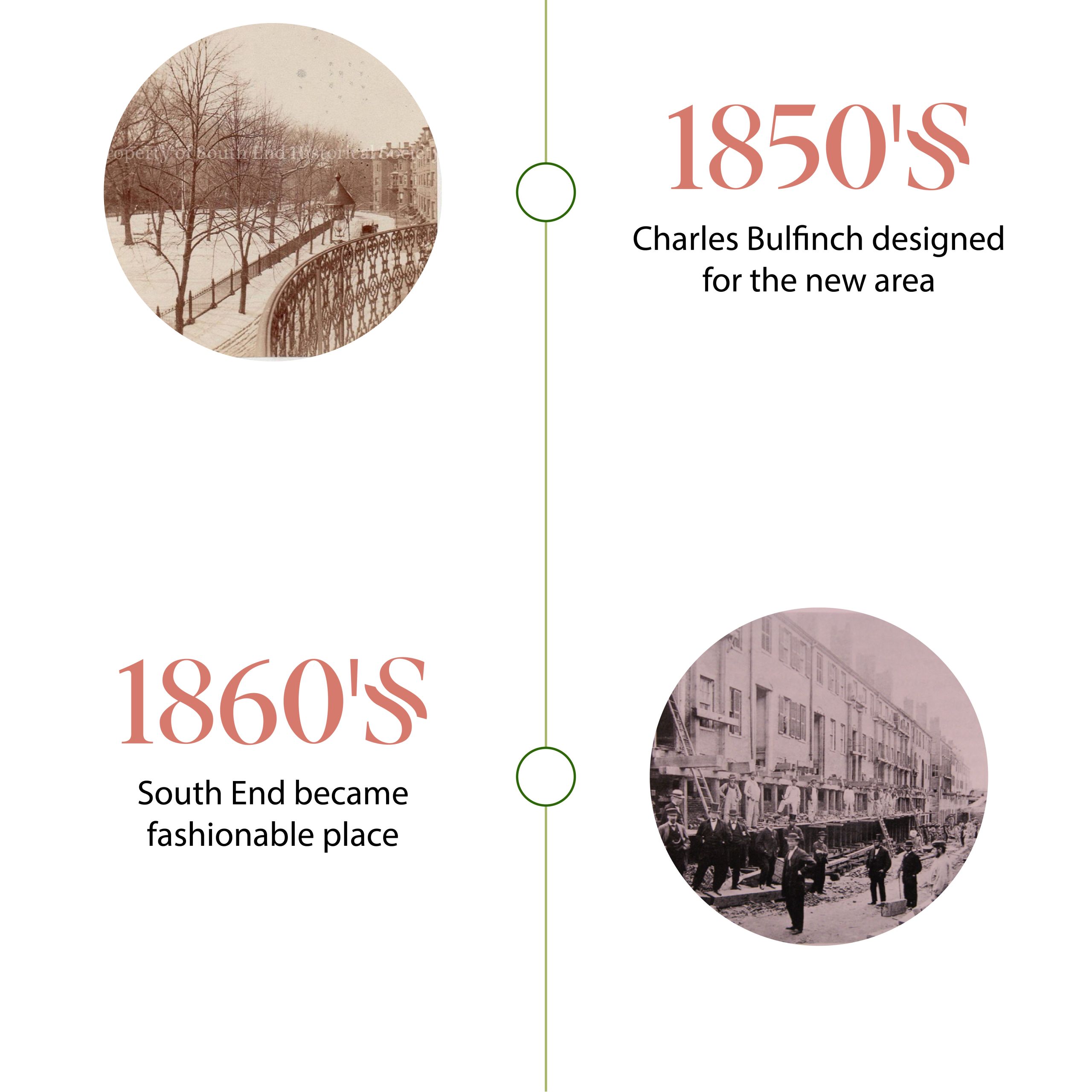
Photo courtesy: South End Historical Society
In the 1850s, Charles Bulfinch, a renowned architect, designed the new area which featured distinctive brick bow-front townhouses, iron railings and gardens. Over the next 15 years, the new South End became a fashionable place. The houses constructed reflect a variety of architectural styles, which, along with many beautiful churches, adding to the visual interest of the area.

Photo courtesy: South End Historical Society
In the 1880s, due to a national financial crisis, elegant houses were repossessed by banks and sold off at low prices, reducing property values throughout the South End. As a result, by the turn of the century, most of the original residents had moved out of the area and the private homes were converted into tenements and lodging houses.
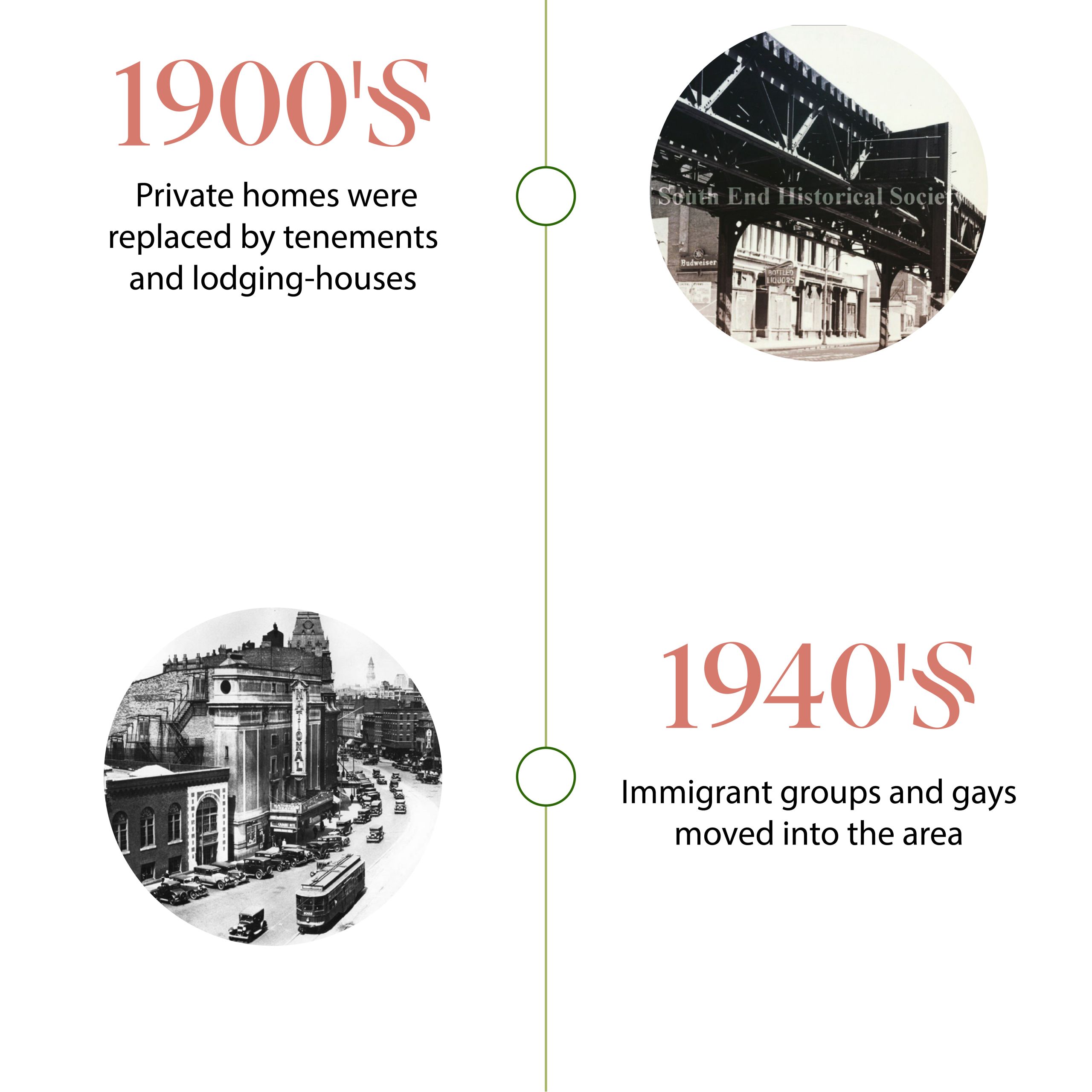
Photo courtesy: South End Historical Society
The South End attracted many ethnic groups, including African Americans and Irish Americans During the 1940s, gay residents were drawn to the South End by the possibility of living discreetly in the many single-sex lodging houses. Waves of various immigrant groups moved into the area as well.

By the 1960s, the area was affected by poverty, and its buildings and gardens were neglected. The South End Historical Society formed at this time to preserve the architecture and culture of this historic district. In 1973, the South End was listed on the National Register of Historic Places as “the largest urban Victorian neighborhood in the country” and named a Boston Landmark District in 1983.
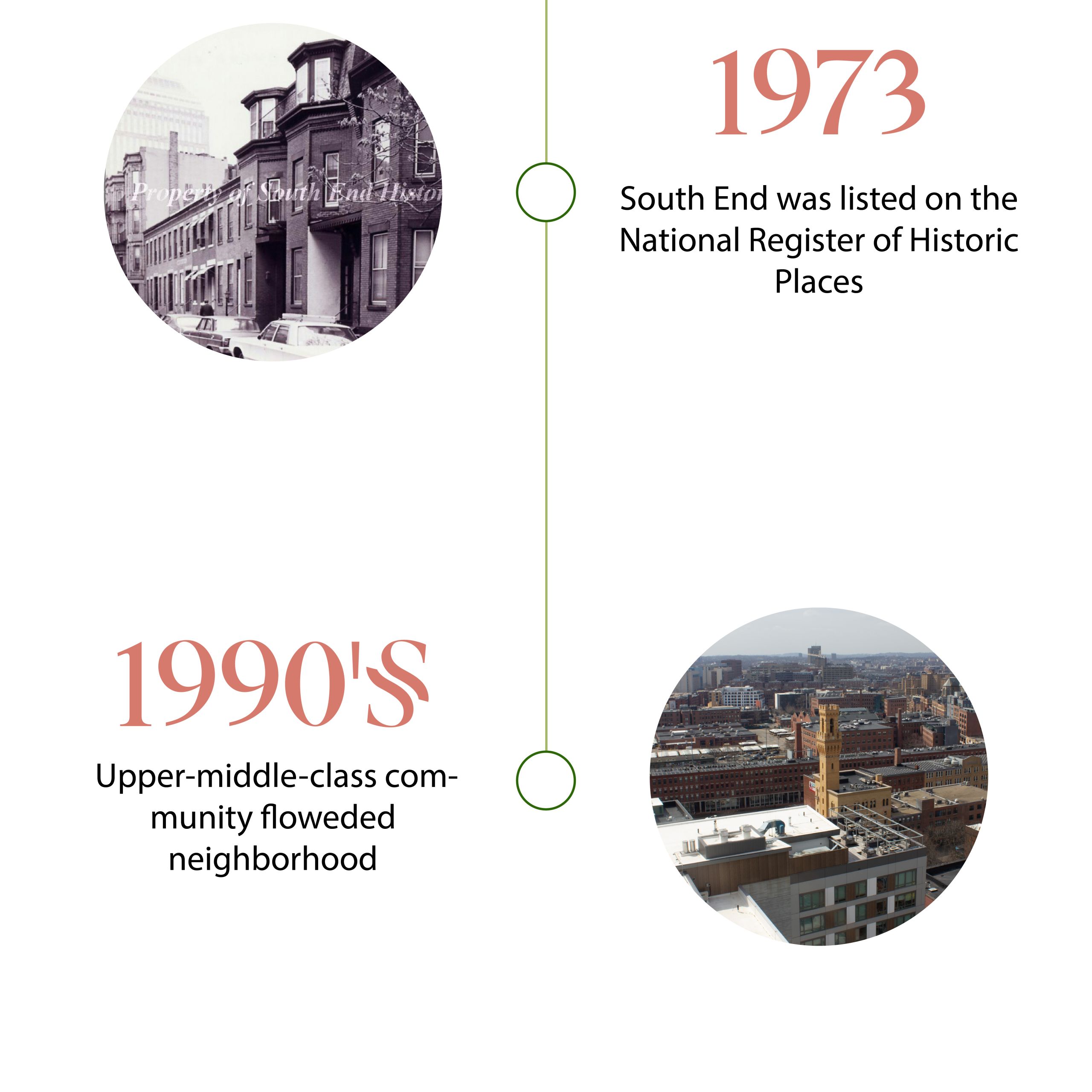
Photo courtesy: South End Historical Society
When rent control ended in Boston in the 1990s, the neighborhood continued to gentrify. Today the South End retains some ethnic diversity and is famous for its trendy restaurants, theaters and attractive brownstone-style homes.

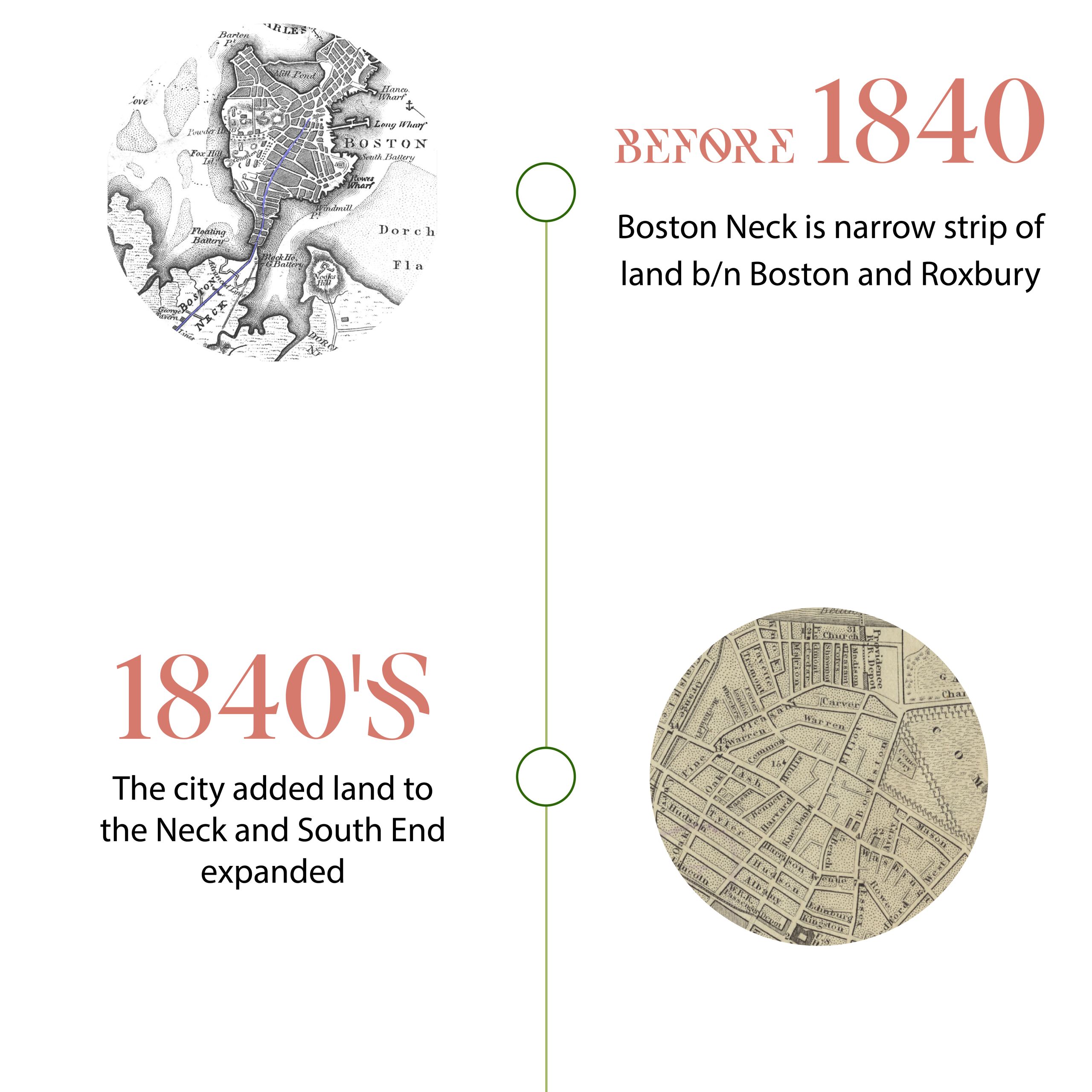
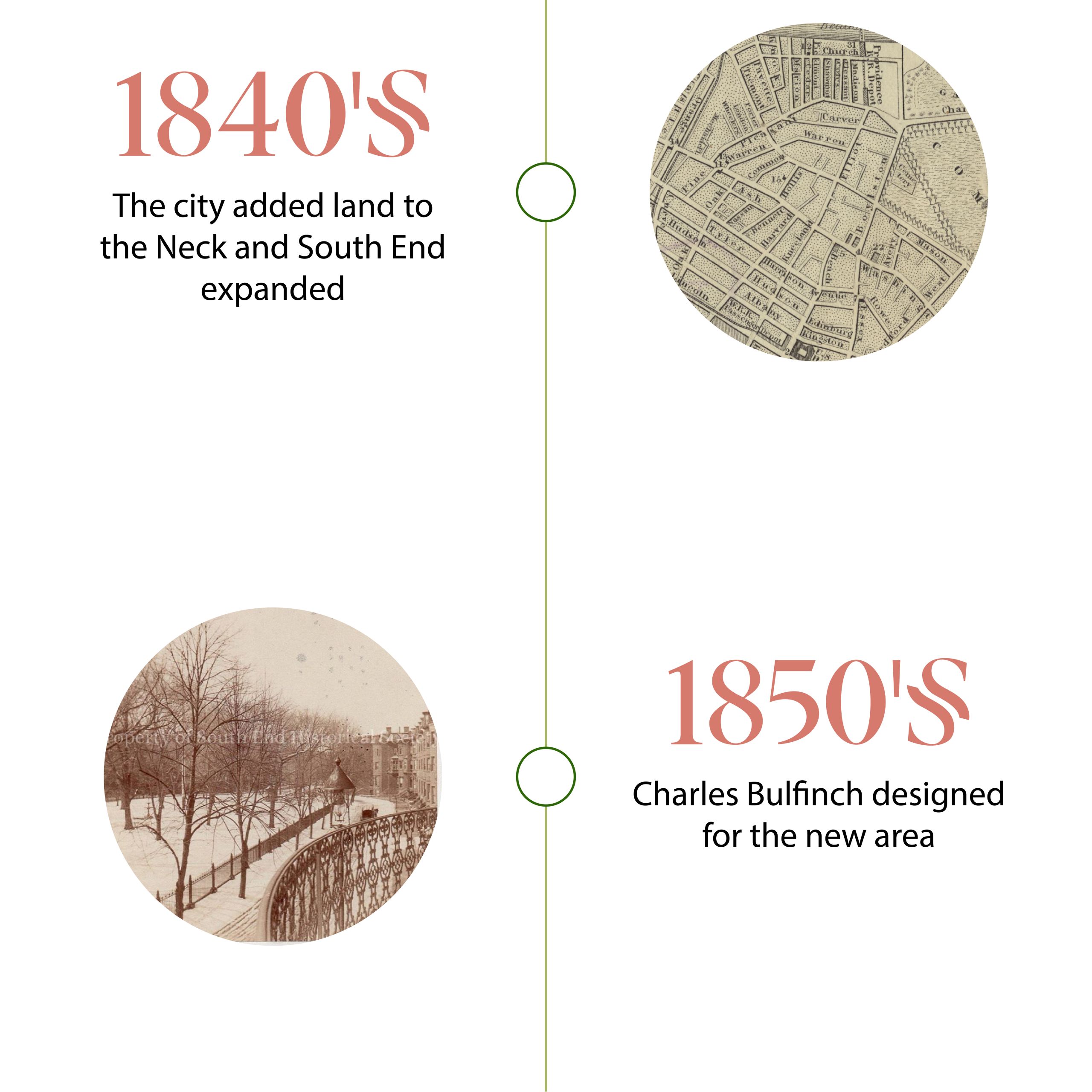
Photo courtesy of: South End Historical Society
Photo courtesy of: South End Historical Society

Photo courtesy: South End Historical Society
Photo courtesy: South End Historical Society
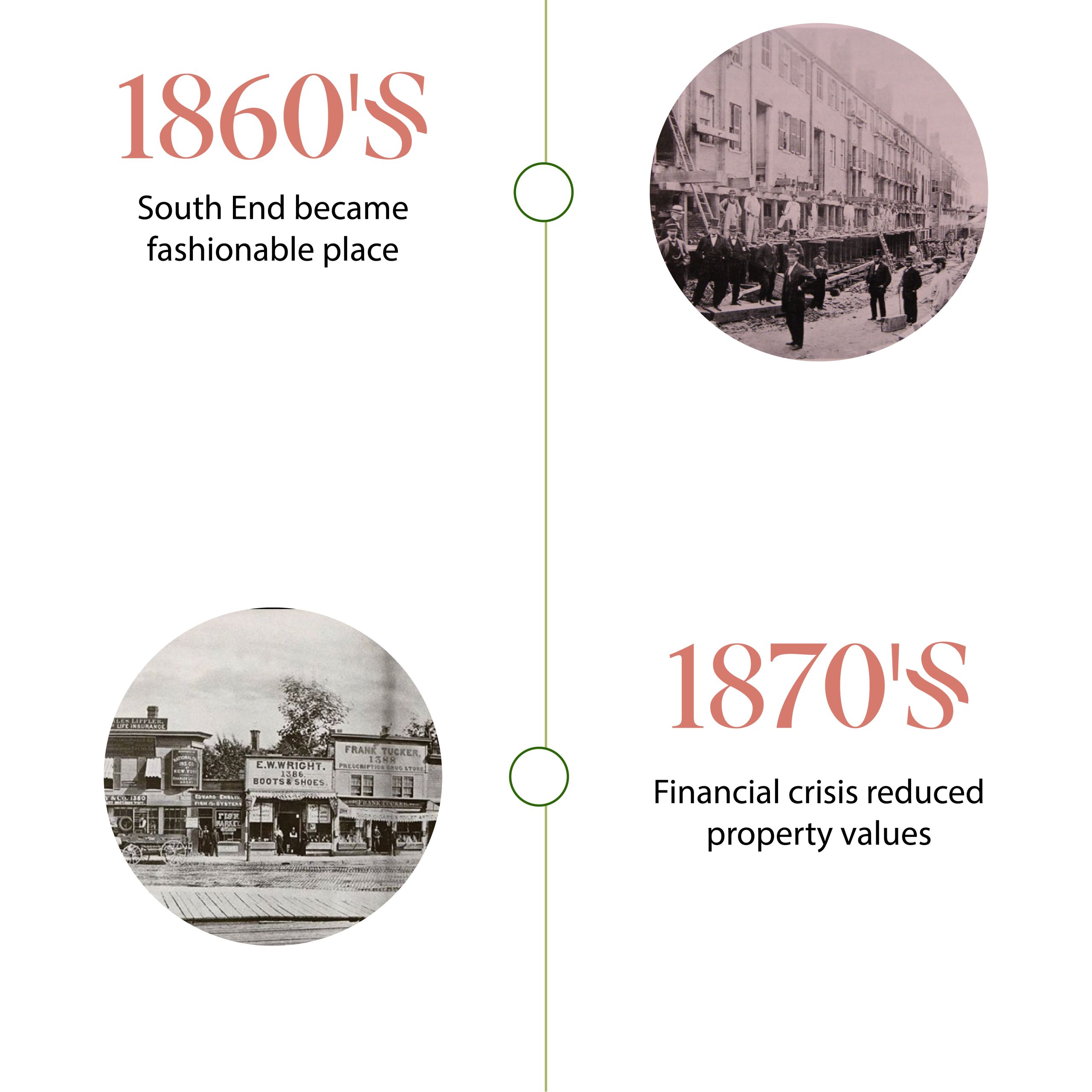
Photo courtesy: South End Historical Society
Photo courtesy: South End Historical Society

Photo courtesy: South End Historical Society
Photo courtesy: South End Historical Society

Photo courtesy: South End Historical Society
Photo courtesy: South End Historical Society
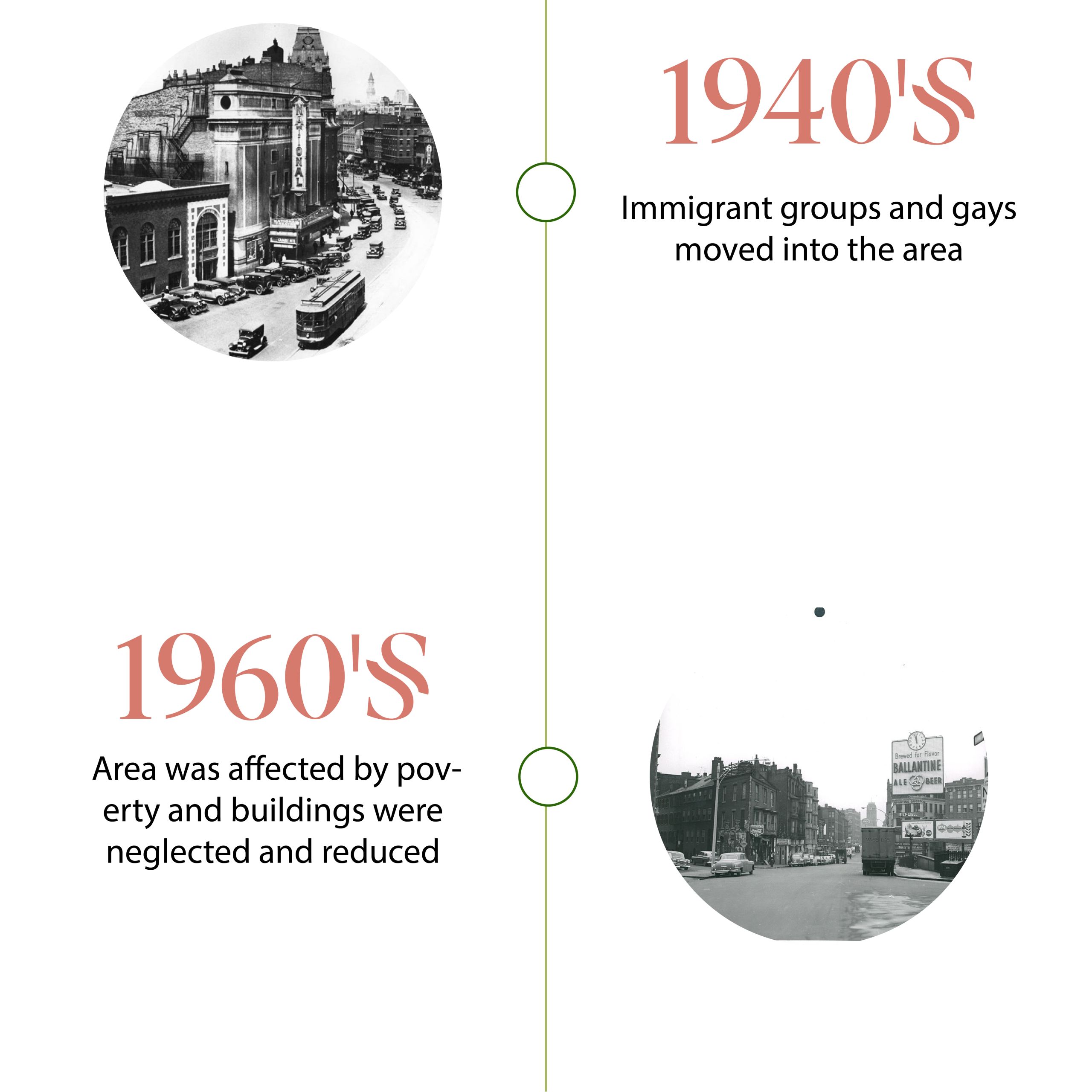
Photo courtesy: Boston Public Library
Photo courtesy: Boston Public Library


Photo courtesy: South End Historical Society
Photo courtesy: South End Historical Society

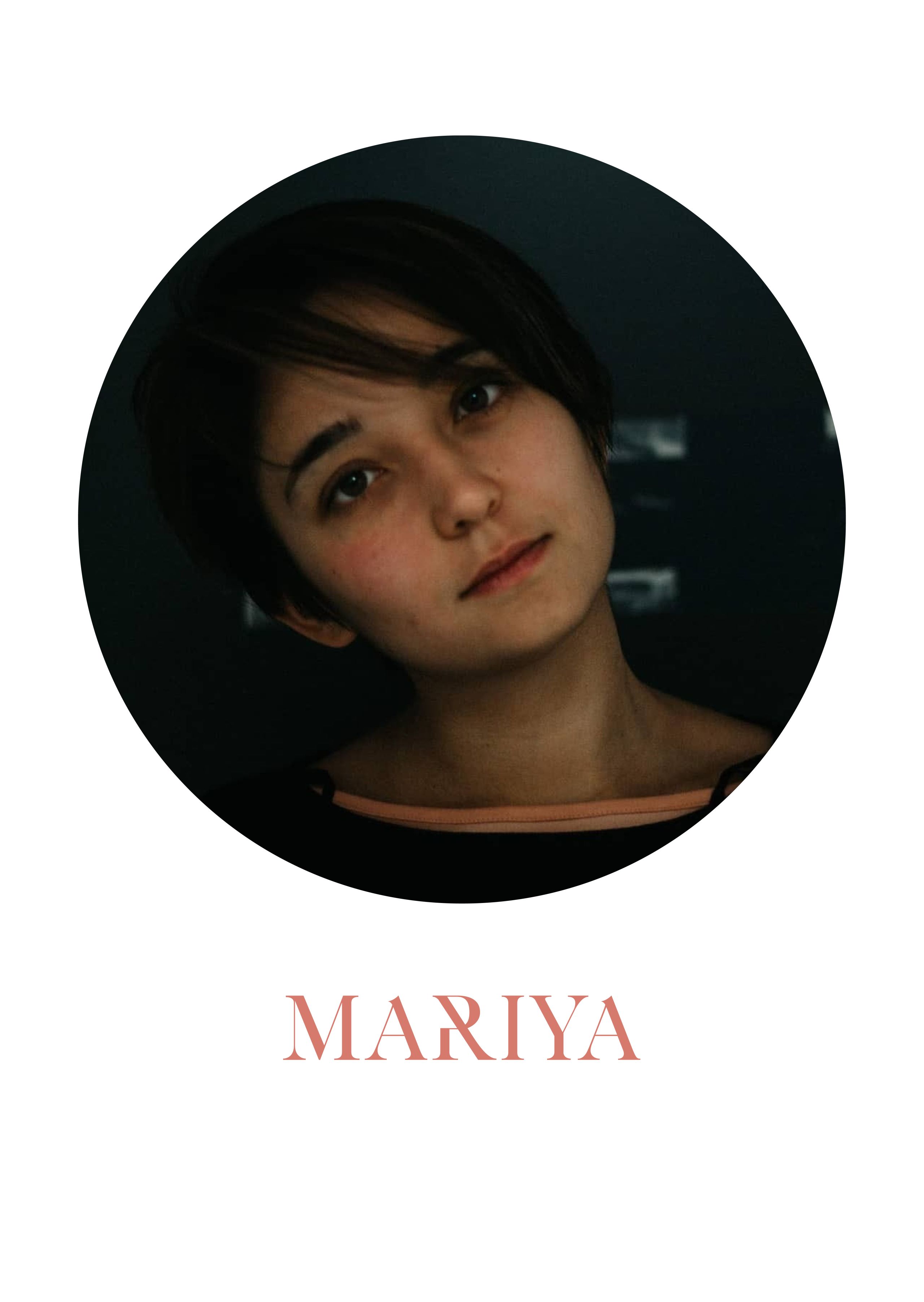
Mariya Amrayeva
Web and Graphic Designer
Mariya Amrayeva is a passionate storyteller passionate with print, online and photojournalism. She is pursuing her master's degree in Journalism at Boston University with concentration in news and magazine writing and investigative reporting.
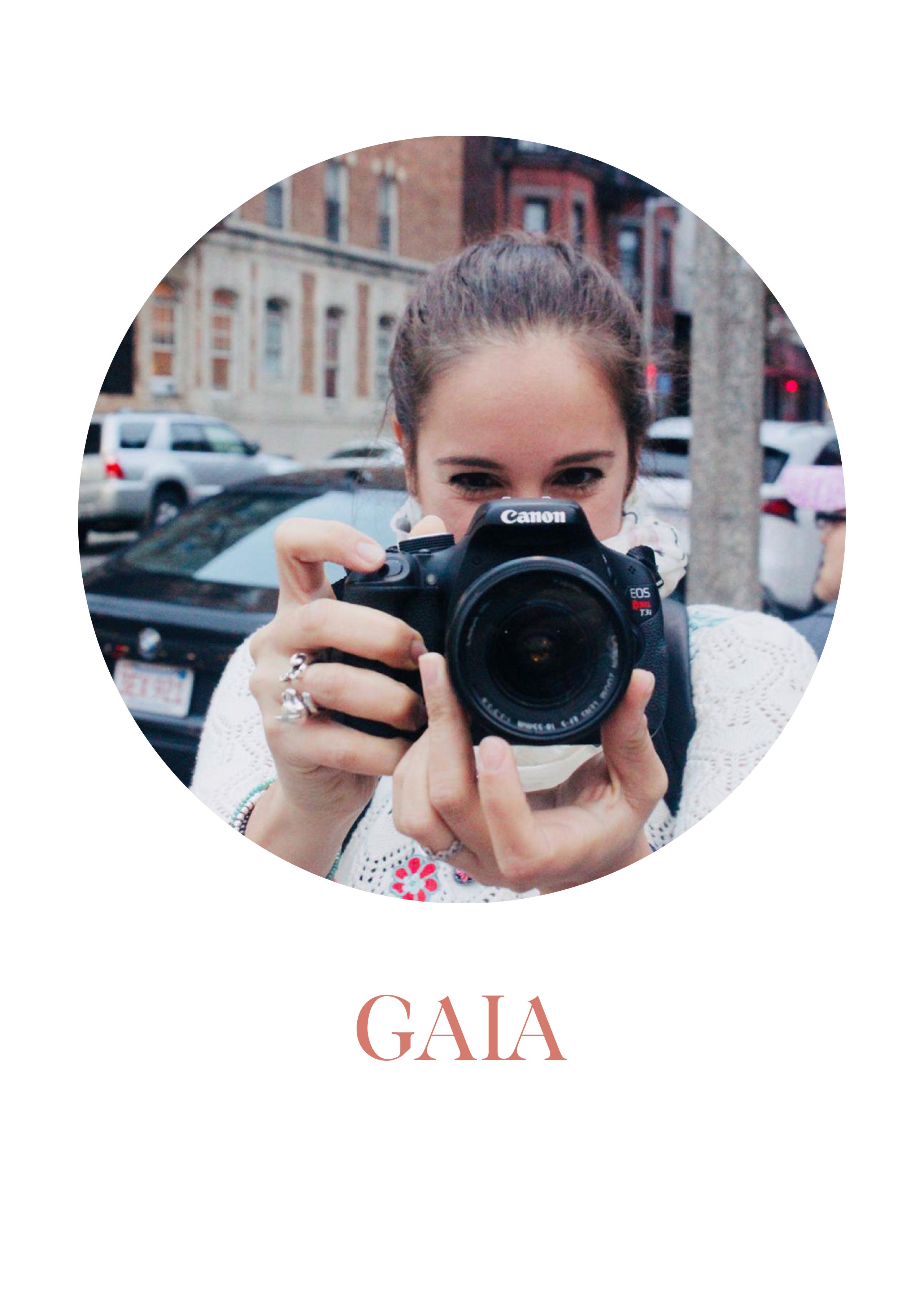
Gaia De Simoni
Video Producer and Video Editor
Gaia De Simoni is a multimedia journalist passionate with sports and documentaries. She is attending her Master of Science in Journalism at the Boston University where she is specializing in storytelling videos and broadcasting.

Heather Saltz
Editor
Heather Saltz obtained her law degree at Nova Southeastern University and is pursuing a Masters in journalism at Boston University. She wants to report on the law and politics.

Andrea Wang
Reporter
Jiayi Wang is an early childhood major graduate student at Boston University. She obtained her journalism degree in Beijing, China. She’s interested in both fields.




